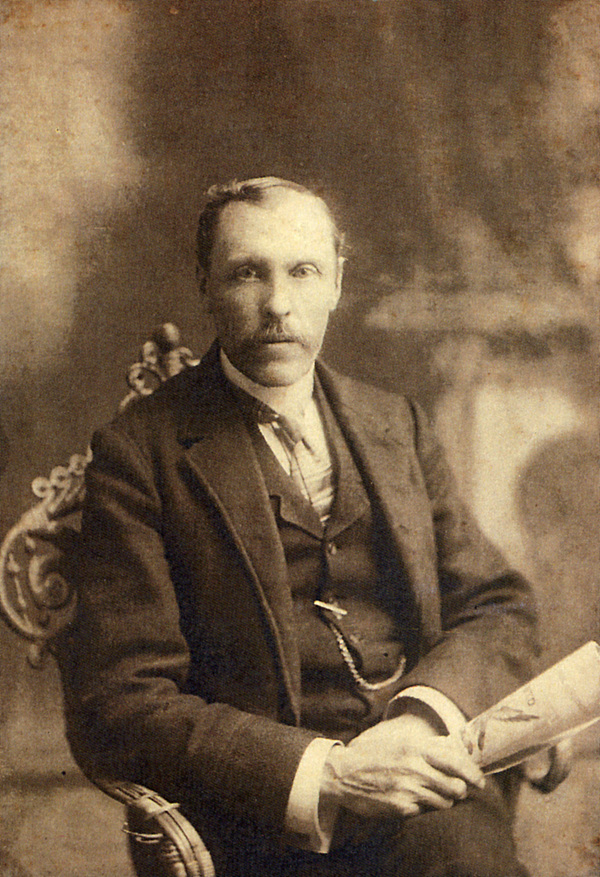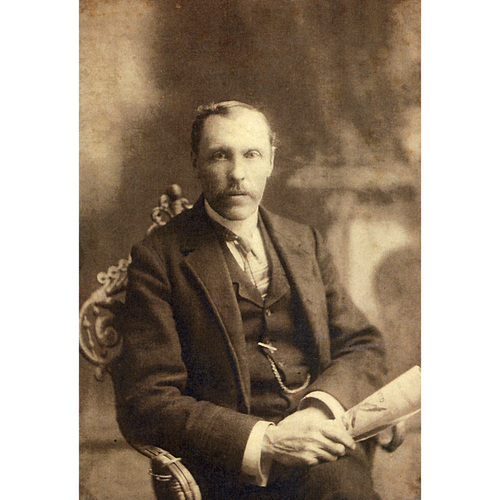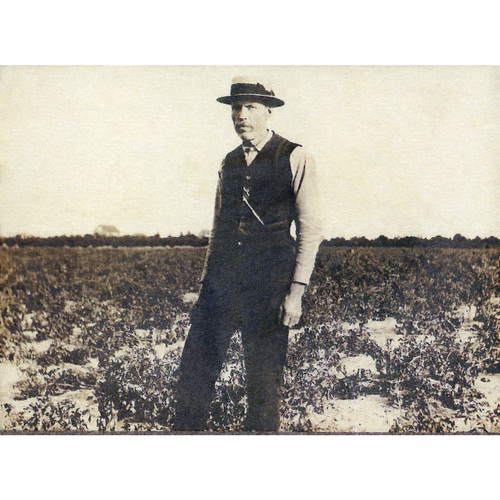
Source: Link
HILBORN, WILLIAM WILSON, horticulturist, author, and civil servant; b. 8 April 1849 in Yarmouth Township, Upper Canada, son of Levi Hilborn, a Quaker minister and farmer, and Dorothea Harvey; m. 5 May 1883 Johanna (Josie) Hartwig in Arkona, Ont., and they had two sons and two daughters; d. 10 Dec. 1921 in Mersea Township, Ont.
At the age of eight months, William Wilson Hilborn moved with his parents and grandparents to a farm in Lambton County, one mile west of the settlement that would become Arkona. He was educated privately by family members. From a young age he experimented with plants and shrubs, always trying to develop better varieties. At the time of his marriage in 1883 to Josie Hartwig, who had taught sign language to the deaf in Michigan, he purchased the adjoining farm and took up the culture of fruit. He began contributing articles on small fruits and their marketability to the Canadian Horticulturist [see Linus Woolverton*] and served as a divisional director of the Fruit Growers’ Association of Ontario. The success of his work attracted the attention of William Saunders*, director of the Dominion Experimental Farms, who in November 1886 selected him to become the first horticulturist at the central farm in Ottawa. There Hilborn would work with such agricultural scientists as James Fletcher* and, when Saunders was away setting up new stations, he oversaw the developing farm.
Hilborn’s intention, according to his horticultural report for 1887, was to promote fruits that could adapt to extreme Canadian weather conditions. Chosen too for their commercial potential, trees were imported from Russia and northern Europe for experimentation. The plantings in the spring of 1887 included 297 varieties of apples, 101 of pears, 72 of plums, and 71 of cherries, as well as 11 American varieties of peaches and apricot trees from Europe and China. Small fruits – grapes, currants, gooseberries, raspberries, blackberries, and strawberries – were also started. In 1889 the Department of Agriculture published, in both English and French, his practical report on strawberry culture.
Hilborn resigned his post in September 1889 and purchased a 70-acre farm near Leamington in Essex County, the most southerly part of Ontario, where the climate and soils were conducive to early yielding crops. Intending to concentrate on peach culture, he immediately made plans to plant different varieties. He began experimenting as well with gooseberries and currants from varieties he had grown in Ottawa. An energetic promoter, in January 1890 he addressed a meeting held in nearby Kingsville for the purpose of setting up the Essex County Horticultural Society. By December, Hilborn and Edward Maxson, a former head florist in the governor general’s gardens in Ottawa, were advertising in the Leamington Post that they had erected large greenhouses for “the growth of choice greenhouse plants, gladioli and dahlia bulbs, fruits and early vegetables.” Mail orders were accepted and the operation was soon shipping vegetables as far away as Quebec and Manitoba.
In December 1891 the managers of the Ontario Agricultural College and Experimental Farm in Guelph asked Hilborn to accompany them around the province to give lectures. Two years later the Fruit Growers’ Association named Hilborn, dominion horticulturist John Craig, and Windsor fruit-grower Alexander McNeill to a committee “to devise a practical scheme for experimental horticulture, contemplating several small stations.” In 1894 ten stations were established under the joint control of the association and the OAC. Hilborn was placed in charge of the southwestern station, at Leamington, where he specialized in peaches and strawberries. The firm of Morris and Wellington, which ran the Fonthill Nurseries in Niagara, was so attracted by the station that it bought a farm west of Leamington and sought Hilborn’s help in an enterprise that involved planting 10,000 peach trees. The Lake Erie and Detroit River Railway put in a special siding to accommodate the shipment of the fruit expected from this farm.
Near the turn of the century, Hilborn had about 100 acres of peaches, plums, pears, and apricots under cultivation. The fruit-growing industry, especially peach culture, had spread rapidly through the southern portion of Essex on farms with sandy soils. In 1895 Hilborn’s brother Joseph Lundy had settled in the area and had begun growing fruit, early vegetables, and greenhouse crops. About 1898, according to one report, over 1,000 acres of orchards could be seen from Inglewood, W. W. Hilborn’s new residence on the Talbot Road. In February 1899 Hilborn and other growers suffered major financial losses when severe frost destroyed most of their trees. Undeterred, Hilborn continued to work with peaches and other plants and small fruits. He had large fields of strawberries and raspberries, including his own variety of blackcap, the Hilborn raspberry, which was planted widely in Canada and the United States. As well, he had his greenhouse operation, grew flowers for sale, and with his wife provided floral arrangements for funerals. Family photographs of Hilborn, some taken in his fields, portray a broad-shouldered man of medium height and build with a weathered face.
Hilborn travelled widely to share his expertise. He prepared award-winning exhibits for international expositions in London, Chicago, and St Louis. A member of the Farmers’ Institute staff of speakers for many years, he addressed meetings in nearly every county in Ontario. He judged fruit as far away as California, and both Hilborn and his son Chester Harvey adjudicated at fall fairs throughout western Ontario. At exhibitions and in business, he always stressed careful selection, top quality produce, precise grading and packing, and presentation in attractive containers.
In August 1912 Hilborn sold ten acres of his farm to the manager of the Windsor, Essex and Lake Shore Rapid Railway, which, according to the Kingsville Reporter, already had one peach orchard about to bear fruit. His remaining land was divided between his sons, Harvey and William Edward, but he retained a three-acre plot at his residence and turned it into a showplace with colourful flowers and ornate shrubs and trees of new and rare varieties. Despite this reduction of his farm, he continued to experiment and, with one of his sons, maintain a large greenhouse. In November 1917 W. W. Hilborn and Son leased its greenhouse to the Dominion Floral Company for the purpose of cultivating carnations and sweet peas “for the city trade.” Four years later complications from cataract surgery led to Hilborn’s death. He was buried in Lakeview Cemetery in Leamington.
A man of ambition and enthusiasm, W. W. Hilborn had enjoyed experimenting and developing new strains of plants, shrubs, and trees, an endeavour that gave him an expert knowledge of soils, climatic factors, fertilization, and entomology. Growing fruit for commercial ventures was also a driving force throughout his life. He was one of the earliest agriculturists in south Essex to promote the industry of growing vegetables and flowers under glass, now a prominent business in the area.
William Wilson Hilborn’s contributions to the Canadian Horticulturist (St Catharines, Ont.; Toronto; etc.) are listed, along with other writings by him, in Science and technology biblio. (Richardson and MacDonald). His report on the growing of strawberries was published as Strawberry culture ([Ottawa, 1889]). A collection of family photographs is in the possession of a granddaughter, co-author Madeline Hilborn Malott of County Road 20, Kingsville, Ont.
AO, RG 80-8-0-812, no.12601. Amherstburg Echo (Amherstburg, Ont.), 1889–1917. Kingsville Reporter, 22 Aug. 1912. Leamington Post (Leamington, Ont.), 18 Dec. 1890, 15 Dec. 1921. T. H. Anstey, One hundred harvests: research branch, Agriculture Canada, 1886–1986 (Ottawa, 1986). Can., Experimental farms service, Fifty years of progress on Dominion Experimental Farms, 1886–1936 (Ottawa, 1939); Parl., Sessional papers, report of the minister of agriculture, app., report of Experimental Farms, 1887, 1889. Commemorative biographical record of the county of Essex, Ontario . . . (Toronto, 1905). B. S. Elliott, The city beyond: a history of Nepean, birthplace of Canada’s capital, 1792–1990 (Nepean, Ont., 1991). Farmer’s Advocate and Home Magazine (London, Ont.), 1892: 630. N. F. Morrison, Garden gateway to Canada: one hundred years of Windsor and Essex County, 1854–1954 (Toronto, 1954). Ont., Dept. of Agriculture, Fruit branch, The fruits of Ontario (Toronto, 1914); Legislature, Sessional papers, 1886, no.6; 1887, no.11; 1893, no.13; 1894, no.37; 1895, no.67; 1900, no.17; 1922, no.44: 19–20.
Cite This Article
Madeline Hilborn Malott and Marilyn Armstrong-Reynolds, “HILBORN, WILLIAM WILSON,” in Dictionary of Canadian Biography, vol. 15, University of Toronto/Université Laval, 2003–, accessed December 31, 2025, https://www.biographi.ca/en/bio/hilborn_william_wilson_15E.html.
The citation above shows the format for footnotes and endnotes according to the Chicago manual of style (16th edition). Information to be used in other citation formats:
| Permalink: | https://www.biographi.ca/en/bio/hilborn_william_wilson_15E.html |
| Author of Article: | Madeline Hilborn Malott and Marilyn Armstrong-Reynolds |
| Title of Article: | HILBORN, WILLIAM WILSON |
| Publication Name: | Dictionary of Canadian Biography, vol. 15 |
| Publisher: | University of Toronto/Université Laval |
| Year of publication: | 2005 |
| Year of revision: | 2005 |
| Access Date: | December 31, 2025 |




